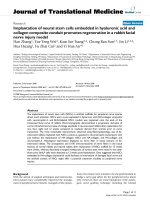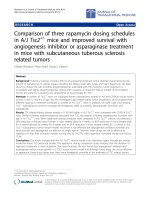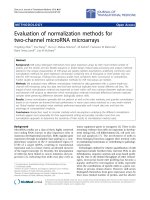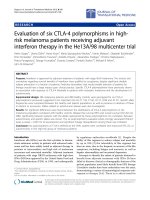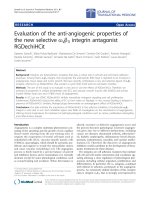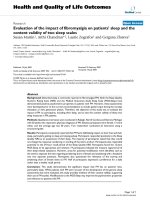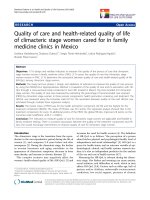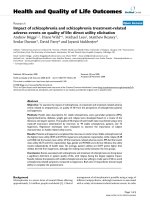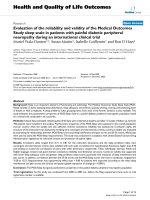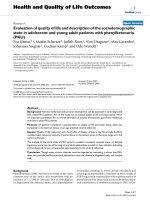báo cáo hóa học:" Evaluation of deformity and hand function in cerebral palsy patients" pdf
Bạn đang xem bản rút gọn của tài liệu. Xem và tải ngay bản đầy đủ của tài liệu tại đây (238.3 KB, 9 trang )
BioMed Central
Page 1 of 9
(page number not for citation purposes)
Journal of Orthopaedic Surgery and
Research
Open Access
Research article
Evaluation of deformity and hand function in cerebral palsy patients
Karlen Law
1
, Ellen Y Lee*
2
, Boris Kwok-Keung Fung
2
, Lam Shuk Yan
1
,
Paata Gudushauri
2
, Kwan Wing Wang
1
, Josephine Wing-Yuk Ip
2
and
Shew Ping Chow
2
Address:
1
Occupational Therapy Department, Duchess of Kent Children's Hospital, 12 Sandy Bay, Pok Fu Lam, Hong Kong and
2
Division of Hand
and Foot Surgery, Department of Orthopaedics and Traumatology, Queen Mary Hospital, 102 Pokfulam Road, Hong Kong
Email: Karlen Law - ; Ellen Y Lee* - ; Boris Kwok-Keung Fung - ;
Lam Shuk Yan - ; Paata Gudushauri - ; Kwan Wing Wang - ;
Josephine Wing-Yuk Ip - ; Shew Ping Chow -
* Corresponding author
Abstract
Background: A cross-sectional study was performed to describe the upper limb deformity and
function in cerebral palsy patients and to determine the correlation of deformity, spasticity, motor
control, and sensation to hand function in the said population.
Materials and methods: Thirty patients satisfying our inclusion criteria underwent physical,
sensory, and functional assessment using a standard protocol. Physical assessment included
documentation of the degree of spasticity, deformity and muscle control. Sensation was tested
using static two-point discrimination test and stereognosis test. Melbourne Assessment of the
Unilateral Upper Limb Function Test (MAULF), Functional Hand Grip Test (FHGT), and Functional
Independence Measure for children (WeeFIM) were used to evaluate hand function. Deformity,
spasticity, motor control, and sensation were analyzed for correlation with hand function using
Pearson Correlation analysis. A p-value of less than 0.05 was considered statistically significant.
Results: Functional deficits of the hand increased with increasing severity of deformity and
spasticity. Tetraplegics were most affected by spasticity, deformity, poor motor control, sensory
and functional deficits. Triplegics, followed by diplegics had more functional upper limbs in terms
of the MAULF and FHGT scores. Unilaterally affected patients (triplegics and hemiplegics) scored
better in performance of activities of daily living. The MAULF and FHGT had a stronger correlation
to deformity, spasticity and motor control compared to the WeeFIM.
Conclusion: The degree of deformity, spasticity, sensory deficit, and motor control affected the
hand function of a cerebral palsy patient significantly. The MAULF and FHGT more accurately
represents hand function deficit in cerebral palsy patients.
Published: 23 December 2008
Journal of Orthopaedic Surgery and Research 2008, 3:52 doi:10.1186/1749-799X-3-52
Received: 17 August 2008
Accepted: 23 December 2008
This article is available from: />© 2008 Law et al; licensee BioMed Central Ltd.
This is an Open Access article distributed under the terms of the Creative Commons Attribution License ( />),
which permits unrestricted use, distribution, and reproduction in any medium, provided the original work is properly cited.
Journal of Orthopaedic Surgery and Research 2008, 3:52 />Page 2 of 9
(page number not for citation purposes)
Background
Cerebral palsy patients with upper limb involvement have
difficulty in performing coordinated movements against
spasticity [1]. Performances of hand tasks in these patients
require gross and fine hand motion coordinated with vis-
ual perception and postural control to enable them to
reach, grasp, release and manipulate objects.
Recent published works on cerebral palsy were focused on
the management of upper extremity deformity and spas-
ticity [2-6]. Though various assessment tools had been
used to assess hand function in this population [3,7-10],
review of literature showed no specific evaluation proto-
col assessing the relationship between the deformity and
its projected function. Functional assessment designed by
House et al. [3] was simple, but did not fully characterize
hand function of cerebral palsy patients. The Melbourne
Assessment of the Unilateral Upper Limb Function
(MAULF) and Quality of Upper Extremity Skills Test
(QUEST) had high inter-rater reliability and construct
validity [11,12].
The main objective of this paper was to describe the upper
limb deformity and function in cerebral palsy patients
with upper extremity involvement, based on the topo-
graphic area involved – diplegia, hemiplegia, triplegia,
and tetraplegia, using an evaluation protocol developed
by our Occupational Therapy Department. Our minor
objectives were as follows: (1) to present an objective and
representative assessment tool for evaluating hand func-
tion in the said population and (2) to evaluate how
deformity, spasticity, sensation, and motor control in cer-
ebral palsy patients affect hand function in activities of
daily living.
This comprehensive documentation of upper limb
deformity and hand function in cerebral palsy patients
would allow us to better understand a difficult problem in
a more global perspective and help us plan subsequent
treatments to improve hand function.
Methods
Study population
From 2002 to 2004, 116 cerebral palsy patients aged 5
years or older with preserved visual and auditory senses
were screened at the Neuromuscular Clinic of the Duchess
of Kent Children's Hospital at Sandy Bay in Hong Kong.
Patients with monoplegia, developmental hand age of
greater than 16 years assessed using the Bruininks-Oseret-
sky (B.O.) Test [13] and the "Chopsticks Manipulation
Test" (CMT) [14], severe mental retardation based on
their Intelligence Quotient (IQ), and those who did not
give informed consent were excluded from the study.
Forty-three patients were recruited and 30 patients (70%)
were present to complete the assessment protocol.
There were 16 females and 14 males aged 6 to 33 years old
(mean age: 12.48 years). There were 8 diplegics (26.7%)
with an average age of 7.53 years old, 9 hemiplegics
(30%) with a mean age of 10.04 years, 3 triplegics (10%)
with an average age of 12.53 years, and 10 tetraplegics
(33.3%) with a mean age of 21.47 years. Seventy percent
had the spastic type of cerebral palsy. (Table 1) 66.7% had
normal intelligence. (Table 2) Fifty percent had bilateral
involvement while 27% and 23% had left and right-sided
involvement, respectively. The study population's devel-
opmental hand age ranged from 5.57 years old to 10.13
years old. Results of the 2 tests for developmental (B.O.
test) and functional (CMT) hand age were similar in all
groups of patients with different topographic involve-
ment.
Study Procedure
Our Occupational Therapy Department developed a
structured assessment protocol for the Upper Limb Cere-
bral Palsy Clinic. This protocol had 4 parts: (1) Physical
Assessment, (2) Sensory Assessment, (3) Developmental
Table 1: Distribution table of the study population in terms of type of cerebral palsy and topographic area of involvement
n = 30 Monoplegia Diplegia Hemiplegia Triplegia Tetraplegia Total
Spastic 0 7 7 1 6 21 (70.0%)
Athetoid 0 1 0 0 1 2 (6.70%)
Ataxic 0 0 1 0 0 1 (3.30%)
Dystonic 0 0 0 2 3 5 (16.7%)
Unknown 0 0 1 0 0 1 (3.30%)
Total 0 8 9 3 10
Journal of Orthopaedic Surgery and Research 2008, 3:52 />Page 3 of 9
(page number not for citation purposes)
Hand Assessment, and (4) Hand Function Assessment
(Table 3). The developmental hand assessment was per-
formed as described above, on all potential subjects, to
exclude those with developmental hand age of greater
than 16 years.
Physical Assessment included classification of deformi-
ties, assessment of muscle tone and motor control. Classi-
fication of typical contracture and deformity was done in
anatomic parts using the following: Gschwind & Tonkin
[2] for the forearm, Zancolli et al. [15] for the hand and
wrist, and House et al. [3] for thumb deformities. Muscle
tone was assessed using the Modified Ashworth Scale of
Spasticity [16]. Motor control was evaluated using the
Zancolli Spastic Hand Evaluation [15], House Functional
Classification [3] and Green Functional Classification [9].
Sensory Assessment involved evaluation of static two-
point discrimination (2-pd) and stereognosis. Static 2-pd
was tested using the Baseline Aesthesiometer. Stereogno-
sis was assessed using the Stereognosis kit (Beechfield
Healthcare, Dublin Ireland).
Hand Function Assessment involved (1) evaluation of
functional discrepancy from normal subjects using the
Melbourne Assessment of the Unilateral Upper Limb
Function Test (MAULF) [7] and Functional Hand Grip
Test (FHGT) [9] and (2) evaluation of the subjects' per-
formance in activities of daily living (ADLs) using the
Functional Independence Measure for Children (WeeFIM,
UB Foundation Activities Inc. 2000).
Two occupational therapists evaluated the study popula-
tion using this protocol in a cross-sectional study. Evalua-
tion was focused on the more severely affected upper limb
of each patient.
Presentation of Results and Data Analysis
The study population was grouped based on topographic
area of involvement (diplegic, hemiplegic, triplegic, tetra-
plegic) for presentation of descriptive results. Descriptive
parameters were presented in terms of rank and percent-
ages. Our assessment protocol focused on deformity, sen-
sation, spasticity, motor control and hand function. The
correlation between hand function and the other 4
parameters (deformity, sensation, spasticity and motor
control) was determined by computing for the correlation
coefficient (r) using Pearson Correlation analysis. A p-
value of less than 0.05 was considered statistically signifi-
cant.
Results
Physical Assessment
Spasticity based on Modified Ashworth Scale
Diplegics, hemiplegics and triplegics had relatively similar
levels of spasticity. The 3 groups had increased tone in the
Table 2: Intelligence level of the study population
n = 30 Diplegia Hemiplegia Triplegia Tetraplegia Total
Normal IQ 5 6 2 7 20(66.7%)
Mild MR 2 2 1 1 6 (20.0%)
Moderate MR 1 1 0 2 4 (13.3%)
Severe MR 0 0 0 0 0 (0.00%)
Profound MR 0 0 0 0 0 (0.00%)
Table 3: Assessment protocol for cerebral palsy patients developed by occupational therapy department
Four part assessment Components
Physical assessment Contractures Deformity Muscle tone
Sensory assessment Static 2 point discrimination Stereognosis
Developmental hand assessment B.O. test Chop Sticks Manipulation Test
Functional hand assessment Melbourne Assessment of the
unilateral upper Limb Function
(MAULF) Test
Functional Hand Grip Test (FHGT) Functional Independence Measure
for children (WeeFIM)
Journal of Orthopaedic Surgery and Research 2008, 3:52 />Page 4 of 9
(page number not for citation purposes)
tested muscle groups with the majority scoring 1 or 1+.
Tetraplegics, with scores of 2 or 3, had marked increase in
muscle tone over a wider range of motion. Pronator teres
(PT) was the most commonly affected upper limb muscle,
regardless of the limb involvement. The Adductor Pollicis
(ADP) and Flexor Pollicis Brevis (FPB) were the least
involved. The intrinsic muscles were less spastic than
extrinsic muscles across all patient groups. (Table 4)
Deformity and Motor Control
Tetraplegics had the most severe deformities and the worst
motor control. Even though diplegics, hemiplegics and
triplegics have similar levels of spasticity, the hemiplegics
had a slightly more severe deformity and worse motor
control when compared to the other two groups. (Table 5
and Table 6)
Sensory Assessment
Tetraplegics had deficits in both stereognosis (9.7) and 2-
pd (6.86 mm). The hemiplegic group had slightly subnor-
mal results in the stereognosis test (8.11). There were no
sensory deficits in both diplegic and triplegic groups.
(Table 7)
Hand Function Assessment
The triplegic group (MAULF 89.87%, FHGT 85.13%) per-
formed best in the upper limb function assessment, fol-
lowed by the diplegic (MAULF 87.96%, FHGT 74.26%),
hemiplegic (MAULF 72.77%, FHGT 61.53%) and lastly,
the tetraplegic group (MAULF 48.84%, FHGT 46.93%).
(Table 8)
The triplegics, with unilateral hand involvement, scored
the highest in the WeeFIM assessment. Hemiplegics
scored better than the diplegics by 22.41% in the WeeFIM
(Table 8). Cerebral palsy patients with unilateral involve-
ment (hemiplegia and triplegia) could perform as well or
better than people without cerebral palsy in ADLs, as
measured by their WeeFIM Quotient when compared to
normal subjects. (Figure 1)
Correlation of parameters with MAULF and FHGT
MAULF and FHGT scores had strong correlation with the
all parameters (Table 9). Among all deformities, thumb
contracture showed the strongest correlation with the
functional performance (MAULF: r = -0.775, p = 0.000;
FHGT: r = -0.662, p = 0.00). A severe thumb deformity was
associated with poorer hand function for both the MAULF
and FHGT.
For individual muscle spasticity, the flexor digitorum
superficialis (FDS) showed the highest correlation with
the MAULF (r = -0.741, p = 0.000) while the adductor pol-
licis (ADP) demonstrated the highest correlation with the
FHGT (r = -0.662, p = 0.000).
Sensory deficits showed a statistically significant correla-
tion with the MAULF, but not with the FHGT (Table 10).
In the MAULF, 2-pd results had a correlation coefficient
(r) of 0.422 (p = 0.002), while that for stereognosis was
0.440 (p = 0.036).
Correlation of 4 parameters with WeeFIM Quotient
Increasing severity of deformity, sensory deficit, spasticity
and motor control were related to decreased hand func-
tion in ADLs, as indicated by the decreasing WeeFIM Quo-
tient (Table 11). Hand and wrist deformity (r = -0.541, p
= 0.002), spasticity of the PT (r = -0.503, p = 0.005) and
Table 4: Results of Modified Ashworth Scale of the affected upper limb
Mean grading n = 30 Diplegia (n = 8) Hemiplegia (n = 9) Triplegia (n = 3) Tetraplegia (n = 10)
Biceps 1+ 1 1+ 1+
Brachioradialis 1+ 1+ 1+ 3
Pronator Teres 1+ 1+ 2 3
Flexor Carpi Ulnaris 1+ 1+ 1+ 2
Flexor Digitorum Superficialis 1 1 1 2
Flexor Digitorum Profundus 1 1 1+ 2
Adductor Pollicis 1 1+ 1+ 1+
Flexor Pollicis Brevis 0 1 1+ 1+
Lumbricals 1 1+ 1+ 1+
Journal of Orthopaedic Surgery and Research 2008, 3:52 />Page 5 of 9
(page number not for citation purposes)
FDS (r = -0.601, p = 0.000), and sensory deficit as meas-
ured by 2-pd (r = -0.519 p = 0.011) were associated with a
lower score.
Discussion
The upper limb deformity and function in patients with
cerebral palsy was described based on the topographic
area of involvement. There was an association between
the degree of spasticity and motor control with the diple-
gic group having the mildest spasticity and best motor
control, while tetraplegics were the most spastic with
poorest motor control. Although the triplegics had
slightly more severe spasticity than the hemiplegics, the
triplegics scored better in the House's and Green's Func-
tional Classifications for motor control. A possible reason
for this could be that the triplegics were older than the
hemiplegics in terms of chronological age and develop-
mental hand age (Table 8) in this study, thus they would
be better adapted to their condition.
Sensory deficits reflected in the 2-pd & stereognosis tests
were dominant in hemiplegics in a previous report [17]
but this was not evident in our results. Sensory deficit was
only noted in tetraplegics in the current study.
Age is an important determinant of hand function. Nor-
mally, hand function develops until the age of 14 then
plateaus. Accommodation and fine motor skills improve
with age, and then deteriorate during old age. The tetra-
plegics in our study had the highest developmental hand
age (Table 8) and based on this alone, should have been
the most functional of the 4 groups. However, this group
performed the poorest in all functional assessments
(Table 8). This implied that hand function was not
dependent on development of fine motor skills alone.
Any deformity, spasticity, sensory deficit and impairment
in motor control would significantly affect hand function.
The clinical features of cerebral palsy – spasticity, deform-
ity, sensory deficit and poor motor control – were most
dominant in the tetraplegics. This group also had the most
pronounced chronologic -developmental hand age gap
(Table 12). Thus, hand function was most affected in this
group of patients.
The WeeFIM was a comprehensive tool for assessing
upper extremity functional deficits in ADLs. Due to their
milder degree of spasticity, diplegics were expected to
have the best performance in the ADLs. Similarly, the
hemiplegics performed better than the tetraplegics. How-
ever, the triplegics were found to be the most functional
of the 4 groups with WeeFIM quotients comparable to
normal subjects. (Figure 1) Better function in the triplegic,
as well as hemiplegic groups, could be brought about by
the one-handed technique using the unaffected upper
limb they adopted during the assessment. The diplegic
group score was affected by involvement of both upper
limbs to a much lesser extent in some patients.
To determine the effect of treatment, a simple standard-
ized test to assess hand function deficit was needed.
Unlike the comprehensive WeeFIM, the MAULF was an
objective test that was easy to accomplish. The specific
instructions of the MAULF were better suited to cerebral
Table 5: Upper limb deformity in different topographic groups
Average Grading (↑ Severity 1 → 4) n = 30 Diplegia (n = 8) Hemiplegia (n = 9) Triplegia (n = 3) Tetraplegia (n = 10)
Tonkin's Scale of forearm deformity 1 2 1 2
Zancolli's Scale of hand & wrist deformity 1 1 1 2
House's scale of thumb deformity 1 2 1 3
Table 6: Motor control of the upper limbs in different topographic groups
Average Grading n = 30 Diplegia (n = 8) Hemiplegia (n = 9) Triplegia (n = 3) Tetraplegia (n = 10)
Zancolli's Spastic Hand Evaluation (↑ Severity 1 → 4) 2 3 2 3
House's Functional Classification (↓ Severity 0 → 8) 7 5 7 4
Green's Functional Classification (↑ Severity 1 → 4) 2 3 2 3
Journal of Orthopaedic Surgery and Research 2008, 3:52 />Page 6 of 9
(page number not for citation purposes)
Table 7: Results of stereognosis and 2-point discrimination tests of the affected upper limb
n = 30 Diplegia (n = 8) Hemiplegia (n = 9) Triplegia (n = 3) Tetraplegia (n = 7)
Stereognosis (0–13) 11.25 8.11 12 9.7
2PD 4.17 mm 4.57 mm 3.67 mm 6.86 mm
Table 8: Results of developmental and functional hand assessment (Ax)
Mean chronological age Developmental Hand Ax Functional Ax ADL Ax
n = 30 B.O. test CMT MAULF FHG WeeFIM
Diplegia 7.53 yr. 5.57 yr. 5.57 yr. 87.96% 74.26% 55.55%
Hemiplegia 10.04 yr. 6.00 yr. 5.72 yr. 72.77% 61.53% 77.96%
Triplegia 12.53 yr. 8.60 yr. 8.60 yr. 89.87% 85.13% 97.09%
Tetraplegia 21.47 yr. 10.13 yr. 9.80 yr. 48.84% 46.93% 42.75%
The self-care score of the WeeFIM in different topographic groupsFigure 1
The self-care score of the WeeFIM in different topographic groups.
˪˸˸˙˜ˠʳˀ˗˼̃˿˸˺˼˴ʳ˦˸˿˹˶˴̅˸
˃
˄˃
˅˃
ˆ˃
ˇ˃
ˈ˃
ˉ˃
˄˅ˆˇˈˉˊˋ
˦˶̂̅˸
˦˸˿˹˶˴̅˸
˦˸˿˹˶˴̅˸ʳ́̂̅̀
˪˸˸˙˜ˠʳˀʳ˛˸̀˼̃˿˸˺˼˴ʳ˦˸˿˹˶˴̅˸
˃
˄˃
˅˃
ˆ˃
ˇ˃
ˈ˃
ˉ˃
˄˅ˆˇˈˉˊˋˌ
˦˶̂̅˸
˦˸˿˹˶˴̅˸
˦˸˿˹˶˴̅˸ʳ́̂̅̀
˪˸˸˙˜ˠʳˀʳ˧̅˼̃˿˸˺˼˴ʳ˦˸˿˹˶˴̅˸
˃
˄˃
˅˃
ˆ˃
ˇ˃
ˈ˃
ˉ˃
˄˅ˆ
˦˶̂̅˸
˦˸˿˹˶˴̅˸
˦˸˿˹˶˴̅˸ʳ́̂̅̀
˪˸˸˙˜ˠʳˀʳ˧˸̇̅˴̃˿˸˺˼˴ʳ˦˸˿˹˶˴̅˸
˃
˄˃
˅˃
ˆ˃
ˇ˃
ˈ˃
ˉ˃
˄˅ˆˇˈˉˊˋˌ˄˃
˦˶̂̅˸
˦˸˿˹˶˴̅˸
˦˸˿˹˶˴̅˸ʳ́̂̅̀
Journal of Orthopaedic Surgery and Research 2008, 3:52 />Page 7 of 9
(page number not for citation purposes)
palsy patients who had problems with motor coordina-
tion and postural control.
The WeeFIM was a global function assessment that tested
for the ability to perform ADLs. The patient performed
certain ADLs and was allowed to use both hands. The
unaffected hand could compensate for the affected side,
giving the false impression that the affected hand's func-
tion was better. The MAULF tested one hand at a time,
such that a unilaterally affected patient would not be able
to compensate. An improvement in the MAULF score
would indicate better function due to treatment and not
because of adaptation of the unaffected limb.
The MAULF (r = -0.626, p = 0.000) and FHGT (r = -0.543,
p = 0.002) had stronger correlation to hand and wrist
deformity than the WeeFIM quotient (r = -0.541 p =
0.002). However, hand sensation did not correlate signif-
Table 9: Correlation of MAULF and FHGT with deformity, spasticity, motor control and sensation
n = 30 MAULF FHGT
rprp
Deformity
Tonkin's Scale of forearm deformity -0.671* 0.000 -0.611* 0.000
Zancolli's Scale of hand & wrist deformity -0.626* 0.000 -0.543* 0.002
House's scale of thumb deformity -0.775* 0.000 -0.662* 0.000
Spasticity
Biceps -0.452* 0.012 -0.442* 0.014
Brachioradialis -0.530* 0.003 -0.521* 0.003
Pronator Teres -0.563* 0.001 -0.560* 0.001
FCU -0.629* 0.000 -0.543* 0.002
FDS -0.741* 0.000 -0.626* 0.000
FDP -0.680* 0.000 -0.599* 0.000
ADP -0.701* 0.000 -0.640* 0.000
FPB -0.684* 0.000 -0.622* 0.000
Lumbricals -0.539* 0.002 -0.571* 0.001
Motor Control
Zancolli's spastic hand evaluation
House's functional classification -0.568* 0.001 -0.643* 0.000
Green's functional classification
Sensation
Stereognosis 0.422* 0.020
2 point discrimination -0.440* 0.036
Journal of Orthopaedic Surgery and Research 2008, 3:52 />Page 8 of 9
(page number not for citation purposes)
icantly with FHGT as it did with MAULF. One should bear
in mind though that the components of the MAULF could
not be analyzed individually, hence it would reflect the
patient's level of dysfunction but not the etiology of dys-
function.
Review of current literature showed no standardized
assessment battery for assessing hand function of cerebral
palsy patients. This study is limited by a low recruitment
rate of 70%. Thirty percent of guardians who initially gave
consent were not present during the appointed evaluation
date. They eventually withdrew their consent on follow-
up, stating that the evaluation process would take too
much time away from the patient's schooling and other
daily activities. The development of a more concise and
simpler evaluation score was considered as the direction
for future studies by the authors.
This protocol was utilized to meet the study's objectives of
generating a comprehensive description of upper limb
deformity and hand function in the present population.
For practical evaluation of hand function in cerebral palsy
patients, the authors recommend the use of the Mel-
bourne Assessment of the Unilateral Upper Limb Func-
tion (MAULF) and the Functional Hand Grip Test (FHGT)
for reasons previously discussed. Further studies using
MAULF and FHGT for evaluating patients before and after
surgical treatment are needed to determine their use in
monitoring treatment outcome for this population.
Conclusion
The degree of deformity, spasticity, sensory deficit, and
motor control affected the hand function of a cerebral
palsy patient significantly. There was a pronounced
chronological – developmental and functional hand age
gap in all groups. The MAULF and FHGT were strongly
correlated to deformity, sensory deficit, spasticity and
motor control; making them more representative assess-
ment tools for evaluation of hand function in the said
population.
Consent
Informed consent for publication was obtained from
patients or their guardians (in case of minors) during
enrollment into the study.
Table 10: The correlation between sensory deficit and functional hand assessment
n = 30 Melbourne Assessment of Unilateral Upper limb Function Functional Hand Grip Test
Stereognosis 2pd Stereognosis 2pd
Coefficient of Variation 0.422* 0.440* 0.315 0.393
Significance 0.020 0.036 0.091 0.063
Table 11: Correlation of WeeFIM quotient with deformity,
spasticity, motor control and sensation
n = 30 WeeFIM Quotient
rp
Deformity
Tonkin's Scale of forearm deformity
Zancolli's Scale of hand & wrist deformity -0.541* 0.002
House's scale of thumb deformity -0.432* 0.017
Spasticity
Biceps -0.384* 0.036
Brachioradialis -0.409* 0.036
Pronator Teres -0.503* 0.005
FCU -0.401* 0.025
FDS -0.601* 0.000
FDP -0.495* 0.005
ADP
FPB
Lumbricals
Motor Control
Zancolli's spastic hand evaluation
House's functional classification -0.362* 0.049
Green's functional classification
Sensation
Stereognosis
2 point discrimination -0.519* 0.011
Journal of Orthopaedic Surgery and Research 2008, 3:52 />Page 9 of 9
(page number not for citation purposes)
Abbreviations
MAULF: The following are abbreviations used in the text:
Melbourne Assessment of the Unilateral Upper Limb
Function Test; FHGT: Functional Hand Grip Test; QUEST:
Quality of Upper Extremity Skills Test; 2-pd: two-point
discrimination; ADLs: Activities of daily living; WeeFIM:
Functional Independence Measure for Children; IQ: Intel-
ligence Quotient; B.O. Test: Bruininks-Oseretsky Test;
CMT: Chopsticks Manipulation Test; PT: Pronator teres;
ADP: Adductor Pollicis; FPB: Flexor Pollicis Brevis; FDS:
Flexor digitorum superficialis; FCU: Flexor carpi ulnaris;
FDP: Flexor digitorum profundus; r: Correlation coeffi-
cient.
Competing interests
The authors declare that they have no competing interests.
Authors' contributions
KL carried out concept design, patient recruitment and
follow-up, data collection and analysis, and manuscript
writing. EYL carried out literature search, data analysis,
manuscript writing and critical revision. BKKF carried out
concept design, literature search, patient follow-up,
review and approval of the manuscript. LSY, PG, KWW
carried out data collection, patient follow up, data analy-
sis and manuscript writing. WYI carried out patient
recruitment, review and approval of the manuscript. SPC
carried out concept design, patient recruitment, review
and approval of the manuscript. All authors read and
approved the final manuscript for publication.
References
1. Flett PJ: Rehabilitation of spasticity and related problems in
childhood cerebral palsy. J Paediatr Child Health 2003, 39:6-14.
2. Gschwind C, Tonkin MA: Surgery for cerebral palsy: Part 1.
Classification and operative procedures for pronation
deformity. J Hand Surg 1992, 17B(4):391-395.
3. House JH, Gwathmey FW, Fidler MO: A dynamic approach to the
thumb-in-palm deformity in cerebral palsy. J Bone Joint Surg
1981, 63(2):216-25.
4. Tonkin MA, Gschwind C: Surgery for cerebral palsy: Part 2.
Flexion deformity of the wrist and fingers. J Hand Surg 1992,
17B(4):396-400.
5. Tonkin M, Hatrick NC, Eckersley JR, Couzens G: Surgery for cer-
ebral palsy Part 3: Classification and operative procedures
for thumb deformity. J Hand Surg 2001, 26(5):465-470.
6. Van Heest E, House H: Upper extremity surgical treatment of
cerebral palsy. J Hand Surg 1999, 24A(2):323-330.
7. Randall MJ, Johnson LM, Reddihough DS: The Melbourne Assessment of
Unilateral Upper Limb Functional Test Administration Manual Melbourne:
Royal Children's Hospital; 1999.
8. DeMatteo C, Law M, Russell D, Pollock N, Rosenbaum P, Walter S:
QUEST: Quality of Upper Extremity Skills Test Hamilton ON: McMaster
University, Neurodevelopmental Clinical Research Unit; 1992.
9. Eliasson AC, Ekholm C, Carlstedt T: Hand function in children
with cerebral palsy after upper-limb tendon transfer and
muscle release. Dev Med Child Neurol 1998, 40:612-2.
10. Arner M, Eliasson AC, Nicklasson S, Sommerstein K, Hägglund G:
Hand Function in Cerebral Palsy. Report of 367 Children in
a Population-Based Longitudinal Health Care Program. J
Hand Surg 2008, 33A(8):1337-1347.
11. Cusick A, Vasquez M, Knowles L, Wallen M: Effect of rater train-
ing on reliability of Melbourne Assessment of Unilateral
Upper Limb Function scores. Dev Med Child Neurol 2005,
47:39-45.
12. DeMatteo C, Law M, Russell D, Pollock N, Rosenbaum P, Walter S:
The reliability and validity of Quality of Upper Extremity
Skills Test. Phys Occup Ther Pediatr 1993, 13(2):1-18.
13. Bruininks H: Bruininks-Oseretsky Test of Motor Proficiency Bloomington,
MN: Pearson Assessments; 1978.
14. Chen HM, Chang JJ: The skill components of a therapeutic
chopstick task and their relationship with hand function
tests. Kaohsiung J Med Sci 1999, 15:704-9.
15. Zancolli EA, Goldner LJ, Swanson AB: Surgery of the spastic hand
in cerebral palsy: Report of the Committee on Spastic Hand
Evaluation. J Hand Surg 1983, 8(5.2):776-772.
16. Bohannon RW, Smith MB: Inter-rater reliability of a modified
Ashworth scale of muscle spasticity. Phys Ther 1987,
67(2):206-7.
17. Van Heest E, House J, Putnam M: Sensibility Deficiencies in the
hands of children with spastic hemiplegia. J Hand Surg 1993,
18(2):278-81.
Table 12: Chronological – Developmental Hand Age Gap
Mean chronological age Developmental Hand Ax Max. discrepancy
n = 30 B.O. test CMT
Diplegia 7.53 yr. 5.57 yr. 5.57 yr. -1.96 yr. (-35.19%)
Hemiplegia 10.04 yr. 6.00 yr. 5.72 yr. -4.32 yr. (-75.52%)
Triplegia 12.53 yr. 8.60 yr. 8.60 yr. -3.93 yr. (-45.70%)
Tetraplegia 21.47 yr. 10.13 yr. 9.80 yr. -11.67 yr. (-119.08%)
